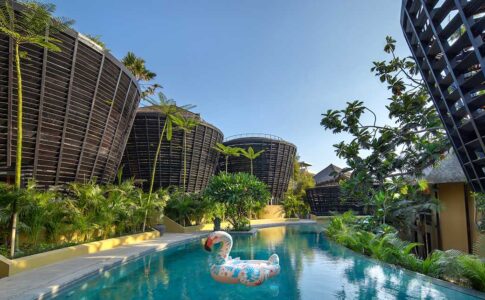Words: Richard Horstman. Image: Oscar Munar.
Bali is a rich and unique optical feast. Yet the ominous visual pollution of billboards and advertising, uninspiring development and urban sprawl, traffic, fumes and idle trash makes for an uber serious contrast. Street Art is radically transforming the urban landscape of the island. Resonating from once lifeless edifices, vibrant and alluring images capture our attention, and ignite the imagination.
Street art fanatic and collector Julien Thorax grew up in Switzerland and then worked across Europe in the corporate world until 2015 when he uprooted and exited for Bali. Owner of the urban art gallery and art supplies store ALLCAPS in Canggu, Julien is the founder of the Tropica Bali Street Art Festival (the urban culture, street art and music event held in Canggu July 2016 & 2017). He is also one of the organizers of the wildly successful new addition to Indonesia’s leading international art fair Art Stage Jakarta 2017 – Off The Wall Jakarta: Europe – ASEAN. Set within 3000 square meters in the Sheraton Grand Jakarta Gandaria City Hotel, Off The Wall Jakarta paired some of Europe’s hottest street artists along with budding ASEAN talent, injecting some urgently needed pizzazz into the exhausted art fair model.
A new urban youth culture has quickly evolved and is now thriving on Bali. The meeting of the art and design, surf, graffiti, mural and hipster communities into a new local/international subculture – its catalyst is the street art scene. Richard Horstman corners the prime mover behind Bali’s burgeoning Street Art scene – Julien Thorax:
Please share a little about your mission?
Firstly, I want to support some of the local artists to make them more visible on the global street art scene, while making Bali a happening destination for graffiti and street artists from around the world. Via ALLCAPS I want to establish an internationally recognized urban art gallery and community space. My endeavor is that within 3-5 years the Tropica Bali Street Art Festival will be the biggest International Street Art and Graffiti Festival in Southeast Asia.
I also want to show local people that graffiti is not always vandalism but can be a beautiful form of modern art, along with utilizing murals and events to spotlight environmental issues, or to support NGOs.
RH: What was the idea behind creating the Bali StreetArt website?
I wanted to help to connect all the local people and communities involved in “Urban Art”, the mural “komunitas” from Denpasar, the graffiti artists, and the stencil artists, who were more or less all working independently from each other. Graffiti boys hanging out with graffiti boys, stencil artists working alone, mural artists staying within their communities in Denpasar. I tried, and succeeded into bringing them under one banner.
Next was to include the international artists visiting Bali. For me, Bali StreetArt is all the “Urban Art” created on the walls of Bali, irrespective of the artist’s origin (Balinese, Javanese, Australian, French, whatever), this is what we achieved with Tropica Festival, among others. And ALLCAPS has become a central meeting point for all urban art artists, and fans.
The side effect is that many of these artists, with their different backgrounds and various creative friends and communities are bringing a lot of other sub or alternative cultures into the movement; musicians, DJs, tattoo artists, skaters etc. All feel confortable coming to ALLCAPS, or to our events because they are sure to meet some of their friends and have a good time. This was happening before I arrived, but we are key into making it bigger and more visible.
Is the Bali street art scene an art movement, or a social movement?
This is more an art movement at the moment that is slowly becoming a social movement. Yet this will take time.
What role is social media playing in this urban art development?
JT: Social media plays a key role, especially in a developing country like Indonesia where the majority of people use smartphones. Instagram is popular because it is easy to use, to connect, and to share. Street art and graffiti artists and fans are making big use of this application. This is directly influencing the way people paint and create murals.
Until recently artists painted murals only in “visible”, prime locations. Nowadays they are keen to paint anywhere, as long as they can get a good “Instagram shot”. They don’t really care if the wall will be seen, or the mural is going to stay up for years. With Instagram they can share instantly to the multitude of global followers. Bali gets visibility and interest on the global scene because of social media due to the unique images we post, such as murals on the beach and in the middle of rice paddies.



































